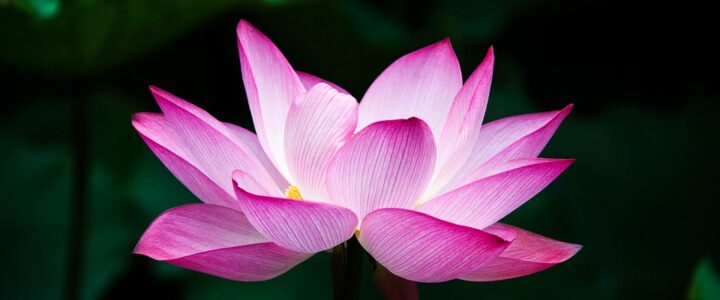Organic Lotus (Nelumbo nucifera), the national flower of India, and Vietnam is also known as Indian Lotus, Sacred Lotus, Water Lily, Bean of India or Egyptian Bean.
It is an aquatic plant grown in water across India, Australia, Vietnam and other Southeast Asian countries.
The roots of the lotus are planted in the soil of the pond or river bottom, while the leaves float on top of the water surface or are held well above it.
The flowers are usually found on thick stems rising several centimeters above the leaves.
The plant normally grows up to a height of about 150 cm and a horizontal spread of up to 3 meters, but some unverified reports place the height as high as over 5 meters.
The leaves may be as large as 60 cm in diameter, while the flowers can be up to 20 cm in diameter.
An individual lotus can live for over a thousand years and has the rare ability to revive into activity after stasis. In 1994, a seed from a sacred lotus, dated at roughly 1,300 years old was successfully germinated.
In Buddhism, the lotus represents the purity of the body, soul and mind.
A unique fabric from the lotus plant fiber is produces a thread used to weave a special robe for the Buddha at Inle lake, Myanmar.
In Ancient Egypt, the lotus flower was an important part of their religion.
It was a symbol of the sun, because at nightfall it closes and goes beneath the water and at dawn it climbs up above the water and reopens, resembling creation and rebirth.
The flowers, seeds, young leaves, and “roots” (rhizomes) are all edible.
In Asia, the petals are sometimes used for garnish, while the large leaves are used as a wrap for food
In Korea, the leaves and petals are used. Young lotus stems are used as a salad ingredient in Vietnamese cuisine.

The rhizome (roots) are used by the Chinese, Indian, Korean & Japanese in everything from vegetable in soups, deep-fried, stir-fried, and braised dishes to traditional Asian herbal medicine.
The petals, leaves, and rhizome (roots) can be eaten raw but it is recommended that they be cooked before eating.
Lotus rootlets are often pickled with rice vinegar, sugar, chili or garlic. In Asian cuisine, it is popular with salad, prawns, sesame oil or coriander leaves.
The stamens can be dried and made into a fragrant herbal tea called liánhuā cha in Chinese. Vietnamese lotus tea is called trà sen, chè sen, or chè ướp sen.
The lotus seeds or nuts are quite versatile, and can be eaten raw or dried and popped like popcorn.
They can also be boiled until soft and made into a paste, or boiled with dried longans and rock sugar to make a sweet soup.
Combined with sugar, lotus seed paste becomes one of the most common ingredients used in pastries such as mooncakes, daifuku, and rice flour pudding.
In South Indian states, the lotus stem is sliced, marinated with salt to dry, and the dried slices are fried and used as a side dish.
The health benefits of organic lotus root can be attributed to its unique mix of vitamins, minerals, and phytonutrients.It is found to be rich in dietary fiber, vitamin C, potassium, thiamine, pantothenic acid, riboflavin, vitamin B6, phosphorus, copper, and manganese, while very low in saturated fat.
Organic Lotus Seed is very low in Saturated Fat, Cholesterol and Sodium while being a good source of Protein, Thiamine, Magnesium, Phosphorus and Potassium, a very good source of Manganese and also contains small amounts of Zinc and Iron.
Lotus seeds contains L-isoaspartyl methyltransferase, an enzyme with anti-ageing properties. It is known to help in repairing damaged proteins
There is also a flavonoid called kaempferol known for its anti-inflammatory properties and it’s ability to help in repairing aging gum tissue.
The astringent properties of lotus seeds make them beneficial for the kidneys by reducing kidney inflammation and helping to regulate the energy levels of the body.
Ancient Chinese and Ayurvedic texts indicate the stems and leaves of the plant are helpful for stomach aches, ulcers and intestinal cramping, increasing circulation, and improving the condition of the heart (cardiotonic).
It is even known for strengthening the spleen.
Consumption of the white lotus causes mild sedation and mild euphoria and has been reported to have both aphrodisiac and anaphrodisiac effects.
There are many who report feelings of floating and euphoric sensations after ingesting a potion made from the white water lily.
In addition to that the Organic Sacred Lotus protects the liver against damage, reduces the effects of UV radiation, inhibits the growth of several types of cancers, enhances cognition, promotes skin health having anti-aging effects on the skin and even increases wound healing abilities.
In yoga the Lotus pose helps to open the hips, strengthen the back and increase flexibility of the knees, it is also used as a base for meditation, chanting, and pranayama (breathing techniques).
The symbol of the Lotus flower, has been a spiritual symbol in Eastern religion for thousands of years with Buddha and Bodhisattvas are often pictured sitting on lotus flowers.
The scent of this Super Power Flower is as heavenly as is it’s amazing gifts.
Ele Naturale


